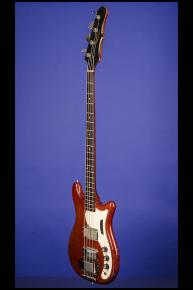Epiphone's "Thunderbird IV" Bass
1965 Epiphone EB-DL Embassy Bass
This Epiphone equivalent of the highly sought-after Gibson Thunderbird bass weighs just 7.60 lbs. Solid 13 inch wide and 1 1/3 inch deep mahogany body, contoured on the bass-side. Three-piece mahogany neck with a narrow nut width of 1 1/2 inches, a scale length of 34 3/8 inches, and a medium to thick profile. Rosewood fretboard with 20 original* medium-jumbo frets, inlaid pearl dot position markers, and small white dot side markers. Black-faced 'batwing' headstock with gold silk-screened Epiphone logo. Individual four-on-a-side open-back bass tuners with cloverleaf metal buttons. Serial number "600179" stamped in black on back of headstock. Two metal-covered pickups with no visible polepieces and very strong outputs of 8.42k and 7.43k. Four-layer white over black plastic pickguard with twelve screws. Thumb brace mounted on pickguard. Three controls (one volume, one tone), all mounted on pickguard. Black plastic knobs with ribbed sides and metal tops. Individual adjustable bridge saddles and stop tailpiece. The potentiometers are stamped "134 6449" (Centralab, December 1964). With the original metal bridge cover (but missing the front cover). This guitar is in excellent plus (8.75) condition. The neck has some surface/playing wear behind the first five frets. There is some finish checking and a few surface marks and indentations - mainly on the sides. The pickguard has two tiny pieces missing from the two top extremities. A very good and all original example. Housed in it's original Epiphone two-latch, gray rectangular hardshell case with black leather ends and blue plush lining (8.75).
*The frets have very little wear which is not commensurate with the wear on the back of the neck - BUT - they do look original with no sign of a refret.
"The Epiphone Company of New York was a major manufacturer of stringed instruments during the first half of the 20th century. It was best known for its fine-quality archtop guitars, but Epiphone also built large numbers of mandolins, banjo's, and upright basses. Gibson president Ted McCarty acquired the company in 1957, and by 1960 he had moved all Epiphone production into the Gibson factory in Kalamazoo, Michigan. From 1961 to 1970, Gibson made thousands of Epiphone basses and guitars, many of which were simply rebranded Gibson models with minor cosmetic differences. This was a clever marketing move: it allowed Gibson to sell Epiphones to music stores competing with nearby Gibson dealers." Almost all of the Epiphone instruments made after 1970 were manufactured in Japan, Taiwan, or (more recently) Korea. The U.S.- made Epiphone bass line from the '60s included the solidbody Newport (single-pickup) and Embassy Deluxe (double-pickup).
"The Embassy Deluxe is the Epiphone equivalent to the highly sought-after Gibson Thunderbird basses, and it has the potential to gain much of the appeal that Thunderbirds hold for collectors and players" (Gruhn's Guide to Vintage Guitars, p. 56).
"Epi's first electric bass, the Rivoli, debuted in 1959, and it was the equivalent of Gibson's EB-2, a semi-hollowbody archtop modeled after the Gibson ES-335 and Epi Sheraton. Solidbody basses soon followed: the Newport in 1961 and the Embassy Deluxe in 1963. The Newport had a single pickup. When guitars went to the six-on-a-side, bat-wing headstock in 1963, the Newport followed, with all four tuners moving to one side…The Embassy Deluxe had two pickups" (Walter Carter, Epiphone: The Complete History, p. 68).











